
We arrived in Berlin with nothing planned or scheduled. First task on the agenda was to take our monster load of wash to a laundry. I figured that if we had it done at the hotel, we would have equalled the national debt. So we filled a suitcase with dirty clothes and wheeled it down the street to the nearest laundry. Turns out it wasn't as close as we thought.
Once that chore was done, we arranged to have an architectural tour of Berlin in the afternoon and a "Jewish" tour the next morning. Our guide for the architectural tour was Nick. He did a very good job of showing us around the city and pointing out many of the new and old architectural highlights.
We made extensive use of the public transportation which is very good in Berlin. Our first stop was the Kaiser Wilhelm Memorial Church. The original church was almost completely destroyed during the war. It was decided that what remained would be made into a museum and a new church would be built along side of the old one. The contrast between the two buildings is striking.
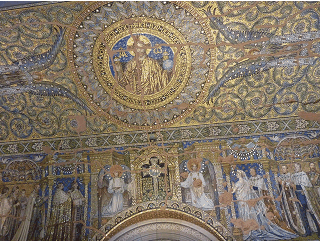
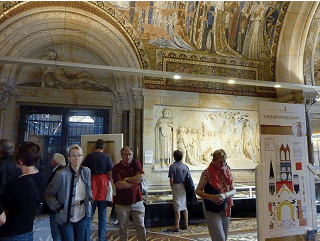
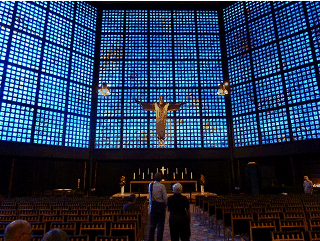
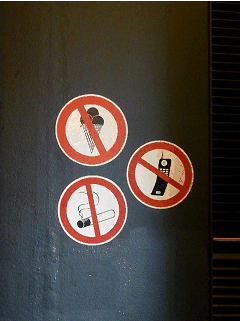
Inside of the old church.
I was amused by this sign on the entry wall of the new church. I guess that means no smoking, no use of a cell phone and no eating ice cream cones.
This station is quite busy. As you can see, it's a very striking modern structure. Once you get the hang if things, it's fairly easy to identify different trains. The red and yellow are local trams, the all red ones are longer runs to different sections of the city, and the white ones are inter-city trains.
It was back on the tram and off to the area of government buildings and a few very important and historic structures. As we walked across the bridge spanning the Spree River, we saw some Berliners enjoying the beautiful weather and catching a few rays. Just beyond them, we came to the Reichstag. Reconstruction was completed in 1999. Then another block away is the Brandenburg Gate. We have vague memories of seeing the Gate and driving into East Berlin in 1958. Needless to say there is no comparison then and now.
Sun bathers on the Spree.
Is that really a pig at this man's feet?
The square on the east side of the Brandenburg Gate is known as Pariser Platz. It was completely destroyed during WWII and rebuilt after reunification of Germany in the 1990s. On the left is the famous Adlon Hotel. On the right is the inside of the DZ bank building which was designed by Frank Gehry. Unfortunately we didn't get a chance to go into the conference room that you see from the outside.
When we exited the DZ bank building on the side opposite the Pariser Platz, we came to the Memorial for the Murdered Jews of Europe also known as the Holocaust Memorial. This an unique and very interesting memorial. As our guide, Nick, said it is open to many different interpretations. It consists of 2711 concrete slabs arranged in a sloping grid pattern. People walking through the paths seem to disappear and then reappear. Because it was late, we didn't get to the attached undergound information center/museum which has a list of all known Jewish Holocaust victims, obtained from the Israeli museum Yad Vashem.
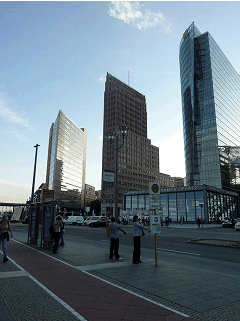
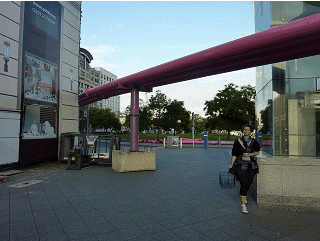
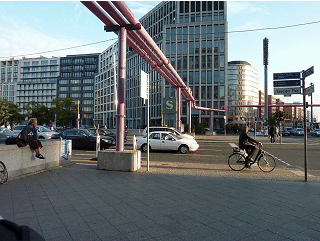
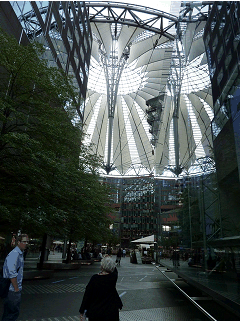
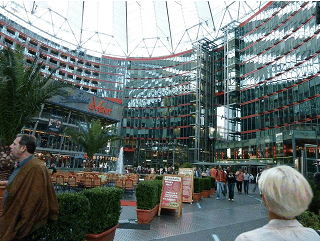
The last stop on our architectural tour was the Potsdamer Platz. This was another square that was totally destroyed in WWII. The story of the rebuilding of Potsdamer Platz that can be found on Wikipedia is quite interesting. What we came to see was the Sony Center. Before we went in, we saw these large "tubes" which were intriguing. Nick said the entire area is subject to undergound seepage and these pipes were used to evacuate the water seeping into the new excavation sites. This may need a little more investigation.
The Sony center is the tall building on the right. The inside is quite spectacular with its unusual ceiling.